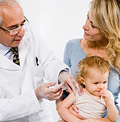 Even in an era when people are increasingly inclined to consult other parents via social media channels and are inundated with information from multiple sources, trust in family doctors has held firm.
Even in an era when people are increasingly inclined to consult other parents via social media channels and are inundated with information from multiple sources, trust in family doctors has held firm.
Dr Glen Nowak, Senior Advisor to Director at the US National Center for Immunization and Respiratory Diseases, Centers for Disease Control and Prevention (CDC), said research revealed that a large proportion of parents have questions or concerns about their children’s vaccination schedules.
“Physicians remain the primary or most trusted source of immunisation information. Patients want to hear doctors’ personal experience with vaccine-preventable disease and side effects,” he said.
Speaking at a Fondation Merieux event in France, he said surveys also showed that most parents reported actively seeking information about childhood vaccines and some even sought to devise their own alternative immunisation schedules.
“The good news is that less than 1% of toddlers [in the US] receive no vaccines at all. Around 83% are vaccinated as recommended and another 11% say they are planning to follow the recommendation – so the social norm is to be vaccinated.”
However, Dr Nowak confirmed that the recommendations from national experts are most effective when delivered by doctors known to the patient.
He differentiated between “vaccine refusers” and “vaccine delayers”, saying the latter tends to see themselves as active partners in making decisions about their family’s health and doctors should be in a position to engage constructively with these patients.
More vaccines recommended
Dr Nowak told the conference that the number of vaccines recommended in 1985 was just seven. By 1995 this had risen to 10 before hitting 16 in 2011. “Immunisation schedules are longer and more complex but we need to find ways to communicate this complexity.”
While increasingly comprehensive immunisation schedules protect children from more diseases and are considered by the vast majority of experts to be safe, adding to the list of recommended vaccinations can worry parents and means doctors need to be prepared to have detailed conversations on immunisation.
“Healthcare providers want easy-to-follow vaccination schedules and access to materials,” Dr Nowak said. For its part, the CDC has published with their patients about immunisation.
“We have found stories to be really important. We create materials for high-information seekers – the minority of parents – who are really interested in vaccines. And we also have resources for other parents who want simpler information.”
He said the window of opportunity to discussing vaccination is “short and fleeting” which many mothers deciding during their pregnancy whether to vaccinate their babies.
While healthcare providers play a crucial role in the decision to vaccinate, doctors’ own vaccination uptake rates are often less than ideal. “If a healthcare provider isn’t vaccinated it undermines their recommendation,” the CDC advisor said.
In Europe, the ECDC has grown concerned that doctors are not doing enough to support vaccination while studies suggest that complacency about vaccine-preventable diseases may be higher in younger doctors who have little experience treating conditions like polio and TB.
‘What’s past is prologue’
The role of healthcare workers in advocating for vaccination was dramatically illustrated during the H1N1 pandemic, according to Dr Michael Schwarzinger of INSERM in France.
The first group to be offered vaccination was healthcare professionals but a survey conducted in the summer of 2009 – at the early stage of the H1N1 flu pandemic – showed just 77% of doctors and 60% of nurses wanted to be vaccinated.
Previous vaccination against seasonal influenza was a major indicator of willingness to be immunised against the new flu strain, according to Dr Schwarzinger’s research. By the end of the summer, when the severity of the pandemic turned out to be milder than first feared, willingness to be vaccinated had fallen to 58% and 46% amongst doctors and nurses respectively.
A survey of GPs suggested they were unwilling to be “guinea pigs” for a new vaccine – a concern often voiced by the public, despite the rigorous safety studies required by regulators before putting vaccines on the market.
The lack of enthusiasm amongst doctors was reflected in the general population and, by the end of the pandemic, just 8% of the public had received the H1N1 vaccine in France.
However, not only was previous uptake of seasonal flu vaccines a driver of pandemic flu vaccination, it now appears that the low level of pandemic flu vaccination in 2009 has carried through into 2010 when seasonal flu immunisation rates in France were around 10% lower than in previous years.
Dr Schwarzinger said the lesson is not only that doctors’ attitudes can influence public opinion on medical matters but that previous behaviours feed into future decisions on whether to be vaccinated.
In short, the impact of the 2009 H1N1 flu pandemic could be felt for many years to come.




VaccinesToday (@VaccinesToday) (@VaccinesToday) (@VaccinesToday) (@VaccinesToday)
December 9th, 2011
Doctor, doctor, I have chronic risk-aversion bias: ‘Patients look to doctors for vaccination advice’ http://t.co/4pSiZ6Wy via @vaccinestoday